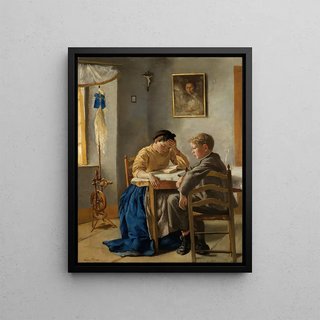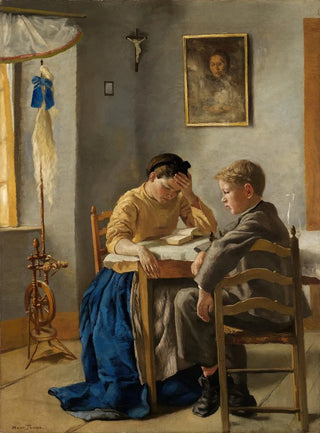Art print | The Brothers and Sisters - Hans Thoma


View from behind

Frame (optional)
In the fascinating universe of art, some works manage to capture the essence of humanity with such depth that they transcend time and space. "The Siblings" by Hans Thoma falls into this category. This piece, imbued with tenderness and melancholy, evokes the unbreakable bonds that unite members of the same family. Through this depiction, Thoma invites us to immerse ourselves in a world where childhood innocence and fraternal complicity harmoniously intertwine. The scene portrayed, rich in emotion, reminds us of the simple beauty of human relationships, while transporting us to an atmosphere filled with nostalgia and sweetness.
Style and uniqueness of the work
Hans Thoma's style is often characterized by a naturalist approach, blended with symbolist elements. In "The Siblings," this duality is expressed through a delicate treatment of the faces and postures of the children, who seem both real and idealized. The chosen colors, soft and pastel, reinforce this sense of serenity. The subtly diffused light highlights the features of the characters while creating a warm ambiance. Thoma excels in capturing the nuances of the human soul, and this work is no exception. It demonstrates undeniable technical mastery, where every detail contributes to the harmony of the whole. The gestures of the children, the tenderness of their exchanged glances, all form a lively tableau, where the viewer can almost feel the warmth of their affection.
The artist and his influence
Hans Thoma, an emblematic figure of 19th-century German art, established himself through his unique vision and his ability to capture moments of life imbued with poetry. Influenced by the Romantic movement, he sought to express deep emotions through his works. His interest in nature and daily life is reflected in "The Siblings," where he manages to celebrate the beauty of human relationships while fitting into a broader context of European art. Thoma was also a pioneer in the use of folkloric and mythological themes, integrating

Matte finish

View from behind

Frame (optional)
In the fascinating universe of art, some works manage to capture the essence of humanity with such depth that they transcend time and space. "The Siblings" by Hans Thoma falls into this category. This piece, imbued with tenderness and melancholy, evokes the unbreakable bonds that unite members of the same family. Through this depiction, Thoma invites us to immerse ourselves in a world where childhood innocence and fraternal complicity harmoniously intertwine. The scene portrayed, rich in emotion, reminds us of the simple beauty of human relationships, while transporting us to an atmosphere filled with nostalgia and sweetness.
Style and uniqueness of the work
Hans Thoma's style is often characterized by a naturalist approach, blended with symbolist elements. In "The Siblings," this duality is expressed through a delicate treatment of the faces and postures of the children, who seem both real and idealized. The chosen colors, soft and pastel, reinforce this sense of serenity. The subtly diffused light highlights the features of the characters while creating a warm ambiance. Thoma excels in capturing the nuances of the human soul, and this work is no exception. It demonstrates undeniable technical mastery, where every detail contributes to the harmony of the whole. The gestures of the children, the tenderness of their exchanged glances, all form a lively tableau, where the viewer can almost feel the warmth of their affection.
The artist and his influence
Hans Thoma, an emblematic figure of 19th-century German art, established himself through his unique vision and his ability to capture moments of life imbued with poetry. Influenced by the Romantic movement, he sought to express deep emotions through his works. His interest in nature and daily life is reflected in "The Siblings," where he manages to celebrate the beauty of human relationships while fitting into a broader context of European art. Thoma was also a pioneer in the use of folkloric and mythological themes, integrating






